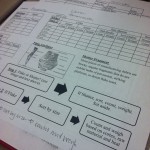Dr. Deanna Grimstead, Associate Professor in the Department of Anthropology of The Ohio State University, and her students are currently working with an Ohio Historical Society Collection from the Proctorville Village Site (Ohio Archaeological Inventory number 33LE12, collection A4197). The collection stems from a 1989 salvage excavation at the location of a large Fort Ancient Village located in Lawrence County. The goals of this project are 1) to use the collection for an introductory undergraduate and graduate level archaeological laboratory methods course, 2) to conduct a thorough zooarchaeological analysis of the archaeofaunal materials from the site, and 3) to further many more collaborative projects between the Ohio Historical Society and The Ohio State University. As part of the course students are giving the opportunity to blog about what they are learning and discovering. The following is the third submission and we hope you enjoy the student’s journeys as much as we will!
Hello again everyone! I have been making some good progress on my assemblage from Proctorville. I finished the faunal analysis and have moved on to the lithic analysis. In my faunal analysis I found many small-medium mammals, and few bird bones, and a lot of turtle shells. This was interesting to me because it made me wonder what the people who lived there were using the turtles for. Could it be food? Or could the turtle shells be used as a bowl or container? Perhaps the turtles held some sort of cultural value for these people. It will be interesting to see what my classmates and I learn in our investigation.
In our last class, we had a presentation about bioarchaeology which I particularly enjoyed. We can learn so much about a person and a culture from the skeletal remains of people, and although it is difficult to condense this into an hour long overview, I think our presenter did a great job. He explained a few of the things you can look at in a skeleton to give an indication about a persons life. For example, we learned about determining sex, age, and ancestry, and well as how to identify some common pathologies or cultura l markers (e.g. artificial cranial deformation). Since this is the focus I have taken in my studies I have found this to be the most interesting part of the course thus far! The last few classes I have been doing lithic analysis, which is something I have never done (only learned about). Because of this, it has taken me awhile to get the hang of sorting the artifacts.
l markers (e.g. artificial cranial deformation). Since this is the focus I have taken in my studies I have found this to be the most interesting part of the course thus far! The last few classes I have been doing lithic analysis, which is something I have never done (only learned about). Because of this, it has taken me awhile to get the hang of sorting the artifacts.
In figure A, I took a picture of the form we have been using to analyze the lithics. Basically we sort the artifacts into debitage (shatter), flakes, cores, and formal tools. My assemblage has been mostly flakes and shatter, but sometimes I have had a lot of difficulty telling the difference between the two. This is especially hard when the pieces are really small, and I’ve had to consult the teacher many times to confirm what an artifact is. My favorite part of the lithic analysis has been seeing the fire burned rock-it is the prettiest bright colors!
I have also found a couple cool artifacts including and this piece of obsidian (Figure B)! As part of my class grade, we are supposed to do a project that answers an archaeological question, and as I was thinking of what I wanted to do, I asked what  might interest me the most. As I really like bones, choosing to study those was kind of a no-brainer. Another thing that really interests me is how cultures change over time and things that drive that cultural change. Because of this I have decided to look to at the frequencies of large vs. small animal remains over time. Stay tuned for my research!
might interest me the most. As I really like bones, choosing to study those was kind of a no-brainer. Another thing that really interests me is how cultures change over time and things that drive that cultural change. Because of this I have decided to look to at the frequencies of large vs. small animal remains over time. Stay tuned for my research!
-Lauren Hammersmith